The tiger is the biggest cat on the planet. It can still be found in the wild in India, and parts of Asia, Russia and China.
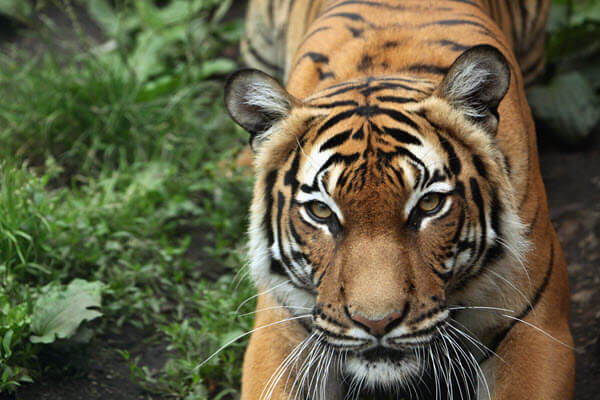
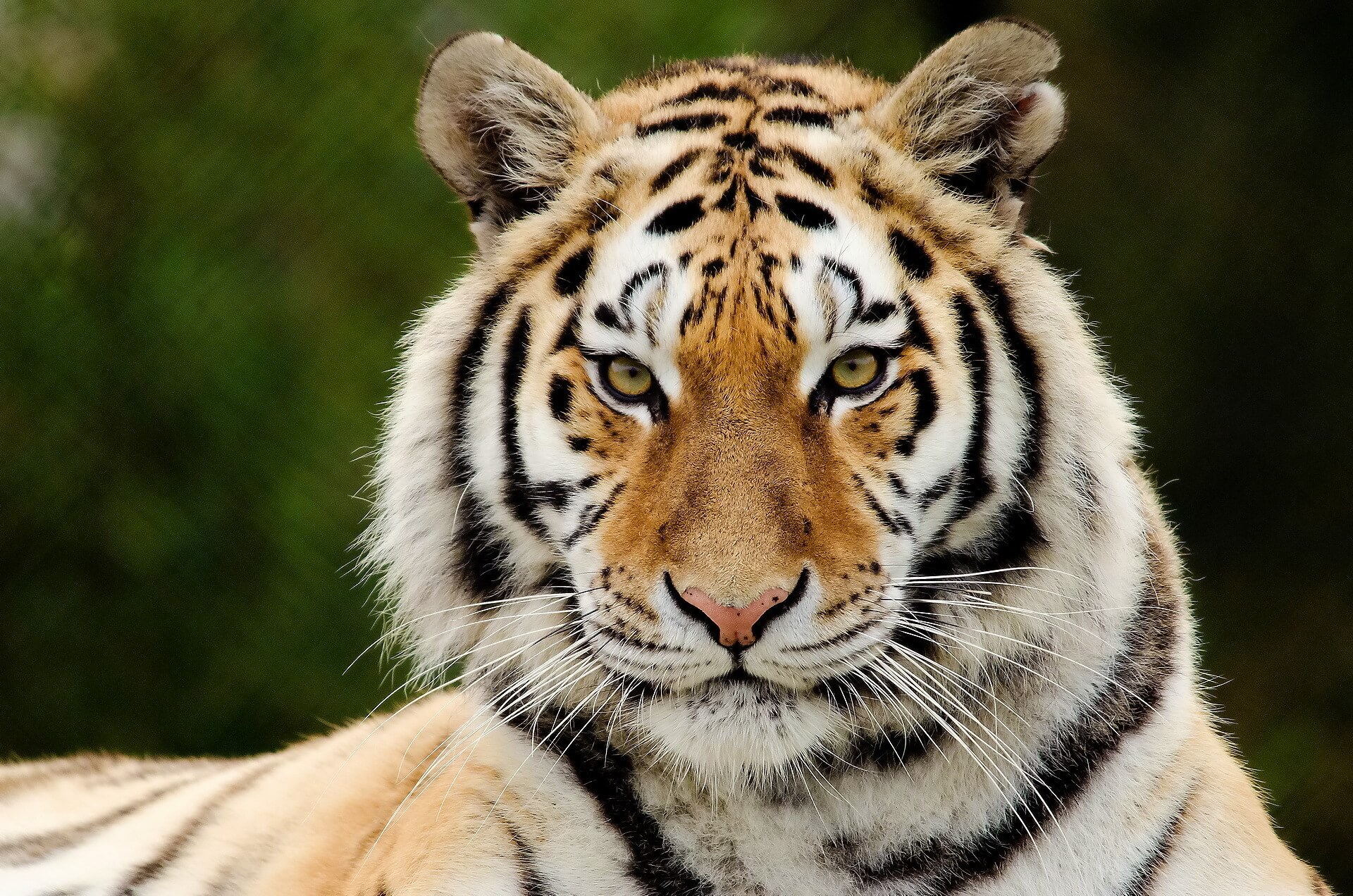
Scientific Name: Panthera tigris
Conservation Status: Endangered
Subspecies: As of 2017, there are only two recognized tiger subspecies:
- Panthera tigris tigris (tigers inhabiting continental Asia) – the original population of a species that has been split into subspecies. Within the Panthera tigris tigris subspecies, there are five living populations of tigers, also known as clades – a group descended from a single ancestor: Bengal, Malayan, Indochinese, South China, Siberian tigerm, as well as the extinct Caspian tiger. (Note: tiger species taxonomy is currently under review by the IUCN SSC Cat Specialist Group.)
- Panthera tigris sondaica (tigers inhabiting the Sunda islands) – the Sumatran tiger; and two extinct island tigers, the Javan and the Bali tigers.
Meaning of the name: From Latin “tigris”, borrowed from Classical Greek “tigris” possibly coming from the Armenian/Persian word for arrow.
Lineage: The tiger is a member of the Panthera lineage,, along with the lion, jaguar, leopard, clouded leopard and snow leopard. There are two genera in this lineage: Panthera and Neofelis.
Population: The wild tiger population is estimated to be between 3,000 to 4,000.
Some interesting tiger facts
- Tigers are larger than any other wild cat.
- They have the biggest canines (long, pointed teeth) of any cat.
- Tigers are the third largest carnivore (meat eater).
- On average, their hunt is only successful one out of ten times.
- When a tiger hunts and kills a large mammal like a deer, it can provide food for a week.
- The largest population of tigers is in India.
- There are more tigers in captivity than in the wild.
- Tigers communicate (vocalization) using many different sounds.
- Tigers like water and swim.
- They are the only cat species that is totally striped.
- The stripe pattern is different from tiger to tiger, like a fingerprint.
- Female tigers flash their ears to communicate with their cubs, warning them of danger.
- A tiger will typically travel 6-12 miles each night when hunting.
Origins and history of tigers
Tigers are members of the genus Panthera, along with the leopard, jaguar, snow leopard, lion and several extinct species. All members of the Panthera genus can roar, except the snow leopard.
Panthera cats separated from other cat species millions of years ago, evolving into the tiger, leopard and snow leopard.
The oldest known tiger species lived over 2 million years ago during the Pleistocene epoch (also called the Ice Age) which lasted from around 2.58 million to 11,700 years ago. Tiger species during this period included the Panthera tigris trinilensis, also known as the Trinil tiger, and Panthera tigris soloensis (from Java and Sumatra), and the Panthera tigris acutidens (from China).
Today’s tiger population began in Indochina and spread throughout Asia.
One of the most well-known prehistoric animals is the saber-toothed tiger (Smilodon). It lived during the early Pleistocene period but was not closely related to the tiger.
More about tigers
Physical appearance
The tiger has a very large and powerful body, big head, strong front legs and wide paws.
Head
Tigers have round ears and a triangular snout with a pink tip. The tip has small black dots, which increase with age. The skull is similar to a lion’s, with a flatter lower jaw. The tiger also has long nasal bones and 30 teeth. Its curved canines are 2.5 – 3.0 inches in length—the longest in the cat family.
Legs and feet
The tiger has five toes with retractable claws, including a dewclaw (a claw on the back of the cat’s leg that doesn’t touch the ground) on each front leg and four retractable claws on each back leg, which can reach up to 3.9 inches. The tiger also has soft toe pads, so it can move quietly when walking and hunting. Its toes are also partially webbed.
Size
Male Siberian tigers can grow up to 12 ft. long and weigh as much as 675 lbs. Female tigers are between 6.5 to 9 feet long and weigh between 140 to 370 lbs. A tiger’s tale is 2 and 3.7 ft. in length. The largest tigers are the Siberian and Bengal tigers.
Fur
The cat’s fur is usually a variation of orange with dark stripes. Their fur varies from white to golden, depending on the species. Most tigers have short hair, about 1.4, except for the Siberian tiger, which can be up to 4.1 inches long. The hair on its belly is longer than the hair on its back. They have lines of fur around their face and long whiskers. Most of the stripes on a tiger are vertical, but some on the legs and forehead are horizontal.
Some tigers are also white. A white tiger is not an albino. Its white appearance results from a genetic variation—a recessive gene. White tigers are either pure or part Bengal tiger and are usually bred in zoos. It is rare to see a white tiger in the wild. They do not live as long as golden-colored tigers, and many have crossed eyes.
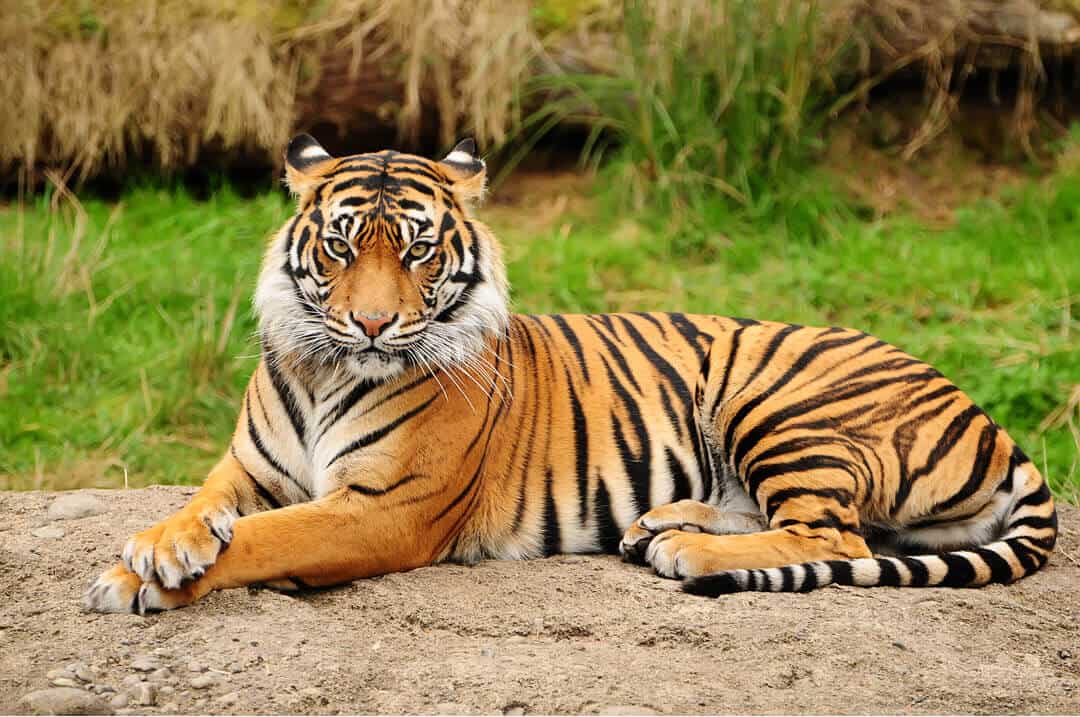
Location and habitat
Tigers could once be found throughout Asia. During the past 100 years, their numbers have plummeted from approximately 100,000 to less than 4,000.
Within the past 15 to 20 years, their range has also decreased by over 40%. Many tigers live in the forest, but you can also find them in grasslands and places where there are hills and rocks, including Central Asia, Russia and China.
In India, which has the largest population of tigers, they inhabit tropical and subtropical forests, alluvial plains (a plain created by sediment from rivers), mangrove forests (swamps and thickets) and the Sundarbans, a mangrove area formed by two large rivers.
Photo: The Sundarbans region in India.

Tiger behavior
Tigers generally lead solitary lives in established territories but are also considered “social.” They are also excellent swimmers and like being near water.
Hunting and prey (diet)
Tigers have been seen hunting during the day and night. They prefer medium to large-hoofed animals such as deer, boar, and buffalo, as well as domestic livestock and, on occasion, leopards, dogs, crocodiles, and bears. They have also been seen eating vegetation. Sometimes, a tiger will share its kill with another tiger. The tiger’s hunting success rate is only 10 to 20 percent.
Photo: A Siberian tiger leaping to catch prey.
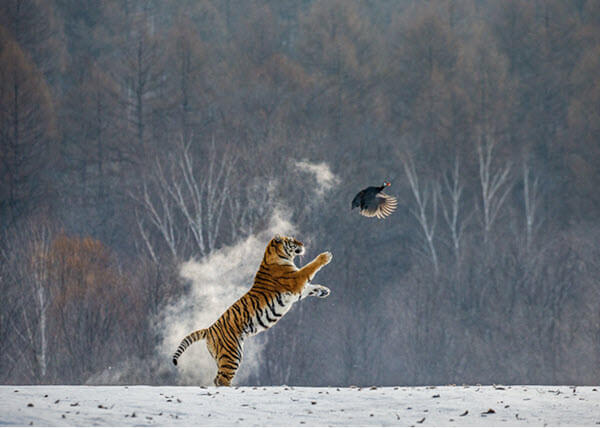
Mating, reproduction and lifespan
Males and females typically mate from November to April. A litter generally has 2 to 3 cubs, ranging from 1 to 6. Cubs usually stay with their mother until they are 2 to 2 ½ years old. Sometimes, a male tiger helps raise the cubs. Tigers live between 20 and 26 years in captivity and the wild.
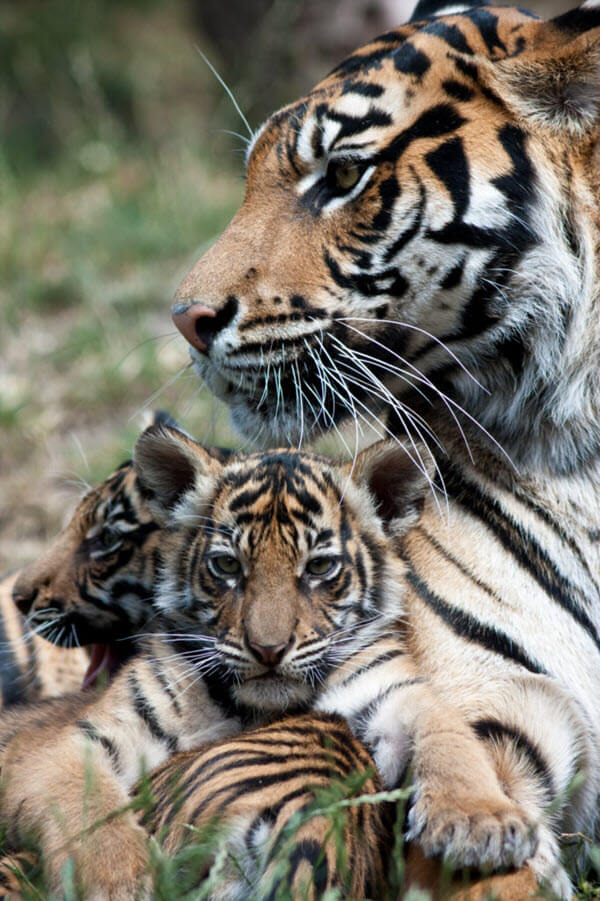
Communication
Tigers communicate with many different vocalizations, including growling, grunting, roaring, moaning, snarling, chuffing, gasping, and hissing. When threatened, the tiger’s pupils widen, it bares its teeth, its ears are pulled back and its face becomes wrinkled. The tigers tail also wags from side to side.
Tiger Conservation
The tiger has been hunted relentlessly for its skin and body parts. Most black marketers involved in the tiger parts trade are based in China. There are also “farms” where the tigers are bred for their parts. It is estimated that between 5,000 and 10,000 tigers currently live on these farms—more than the current wild tiger population.
Approximately 75% of the world’s tiger population inhabits India. In 1972, the Wildlife Protection Act was implemented to protect both plants and animals, including the Bengal tiger. In addition to strict tiger conservation regulations, each state in India was required to create a Tiger Conservation Plan. India’s Project Tiger is another conservation program with activities that include the creation of tiger reserves. As of 2024, there are 55 protected areas in India that are now designated tiger reserves.
Tigers in Culture
Historically, tigers could once be found in eastern Turkey, northern Iran, and Afghanistan, as well as Central Asia, from northern Pakistan through the Indian subcontinent (India, Nepal, Bangladesh, Bhutan, and Sri Lanka) and Indochina (Cambodia, China, Laos, Myanmar, Thailand, and Vietnam) to southeastern Siberia, Sumatra, Java, and Bali.
They have played a significant role in the culture of these regions, from beliefs, rituals, and folklore to art, literature, and even music.
 China
China
In China, tigers have been worshiped and honored for many thousands of years. They represent strength, power, courage, dignity, and protection, and they are believed to keep evil spirits at bay. They are also associated with the god of wealth and are considered a symbol of good fortune.
You can find them depicted in rock art (carvings) dating back to the Neolithic Age (7000 – 1700 BCE), which marks the beginning of human settlements.
In Chinese mythology, five tigers—the white tiger, black tiger, blue tiger, red tiger, and yellow tiger — keep the balance of cosmic forces in place and prevent the universe from descending into chaos.
Here is some more interesting information about the tiger in Chinese culture:
- In China, the tiger is known as the king of beasts.
- The tiger is the third animal in the Chinese zodiac.
- Tsai Shen Yeh, the Chinese god of wealth, is usually seen sitting on tigers.
- The Chunyu is an ancient percussion instrument with a tiger-shaped handle. It was often paired with drums and used to command troops’ advance and retreat on the battlefield.
- “Two Tigers cannot Hide in the Same Mountain” and “He who rides a tiger is afraid to dismount are two famous Chinese proverbs.
- Tiger-head shoes are traditional footwear made for children with the hope that they will grow up strong like tigers and be protected from evil. Hats with tiger images are also worn.
- Hanging a picture of a tiger in your home will prevent ghosts from entering and protect it.
- In ancient China, tiger figurines (tiger tallies) were used to verify military orders sent from rulers to generals.
- According to The Book of Rites, a collection of texts describing Zhou dynasty ceremonial rites, social norms, and government administration, “Tigers are good for people because they eat boars, which are harmful to crops in the field.”
 Korea
Korea
The Amur/Siberian tiger once inhabited forests throughout Korea, Northern China, and Eastern Russia. There were so many tigers in Korea that it was once known as the “Land of the Tigers.”
In Korean culture, the tiger is associated with power, strength, and protection. It can expel malicious spirits and is considered a guardian of the mountains. It is also a sacred animal that brings good luck. In various Korean legends, it is a symbol of courage and loyalty.
Other facts about tigers in Korea:
- In Korean art, tigers are never shown roaring. Instead, they are depicted with benevolent or stern expressions and mischievous grins
- Tigers are in several Korean folktales, including Dangun (Korea’s creation story) and The Tiger and the Dried Persimmon.
- During the 1988 Summer Olympic Games in Seoul, Korea, the mascot “Hodori the Tiger” represented the country. In 2018 , at the PyeongChang Winter Olympics, Korea was also represented by a tiger called Soohorang.
- A belt buckle featuring a humorous depiction of a tiger and its cub was found in Cheongju, South Korea, at a location believed to have existed between the first century BC and the third century AD.
- You can find pre-historic images of tigers carved into rocks at Bangudae Terrace in southeastern South Korea near the eastern end of the Taebaek Mountains.
- Beginning in the early Joseon Dynasty, paintings regularly featured tiger to ward off evil spirits.
- Korea’s national soccer team is called the “tiger of Asia.” The player’s uniforms have a tiger emblem.
India
Today, seventy percent of the world’s wild tigers live in India. In Indian culture, the tiger has long been a symbol of strength, power, beauty, and ferocity. It is also associated with royalty, valor, and bravery.
More about tigers in India:
- The Bengal tiger is India’s national animal.
- In Kerala, a state on India’s Malabor Coast, Lord Ayyappan, the Hindu deity of truth and righteousness and the son of the Hindu god Shiva, is often shown riding a tiger
- In Hindu mythology, the goddess Durga is also depicted riding a tiger.
- Bonbibi, the goddess of the Sundarbans, also rides a tiger.
- Early images of the tiger, dating back over 10,000 years, can be found in rock art in Madhya Pradesh (a state in central India).
- Bagheshwar, the tiger god, is revered and worshiped by several tribes in Central India, including the forest-dwelling Bharia people.
Image: The goddess Durga riding a tiger.
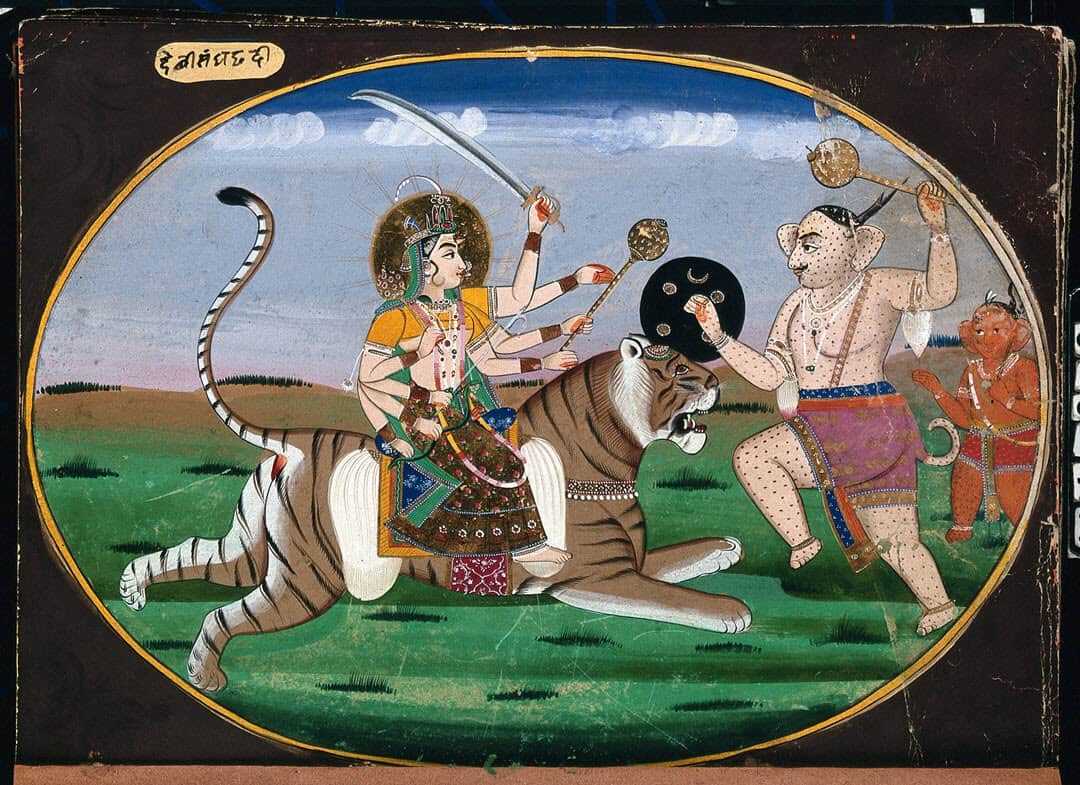

Coat of arms Vladivostok Russia
Russia

Coat of arms Vladivostok Russia
Russia has been home to two tiger species, the Siberian (Amur) and Caspian.
Siberian tigers inhabit the Russian Far East (the easternmost part of Russia and the Asian continent). The Caspian tiger was found in Russia’s southern region until the Middle Ages.
It is believed that the ancestors of these tigers colonized Central Asia less than 10,000 years ago. Tiger rock carvings around the Kiya and Amur rivers are many thousands of years old.
Tigers are deeply connected to the indigenous populations still inhabiting the Russian Far East, including the Nivkhi, Nanays, Negidals, Ulchi, Udegeys, and Oroks.
Although tigers are considered guardians and admired for their strength, power, and agility, they are also feared.
You will find tigers depicted in various types of Russian folk art. There are also several Russian folktales featuring tigers, such as:
- The Seven Fears
- The Little Girl Elga
- The Greedy Kanchuga
Tiger images can even be found on several Russian cities’ flags and coats of arms, including Vladivostok and Khabarovsk.
 Japan
Japan
Tigers never inhabited Japan, but they are part of its culture. They represent strength and courage. Along with the dragon, they are believed to govern the rain and wind.
- The Japanese word for tiger is “tora”, an abbreviation of the words ‘totsugeki raigeki’ meaning: lightning attack.”
- In art, the tiger protects against demons, bad fortune, and illnesses.
- An image of a tiger is commonly used in tattoos.
- The tiger is the guardian deity of the Chogosonshi-ji Temple, which was built around 1,400 years ago.
- You can also find giant tiger statues on both sides of the main entrance to Kuramadera Temple in northern Kyoto. The temple was built in the eighth century.
Western Culture
In Western countries, tigers are depicted in many forms of art and literature, as well as entertainment, sports, and even advertising.
Famous fictional tigers include:
- Hobbes (Calvin and Hobbes) – an American comic strip from 1985 to 1995.
- Tony the Tiger – Used to market Kellog’s Frosted Flakes
- Tigger – a character in Winnie-the-pooh books.
- Shere Khan – a character in The Jungle Book.
Famous paintings featuring tigers:
- Tiger in a Tropical Storm – Henri Rousseau, 1891
- A Young Tiger Playing with its Mother – Eugene Delacroix 1830-1831
- Tiger’s Head – Abbott Handerson Thayer, 1874
- Tiger Lying on a Rock Plateau – Wilhelm Kuhnert, 1912
- A Tiger Prowling in the Snow – Hugo Ungewitter, 1912
- Tiger and cubs – Jean-Leon Gerome, 1884
Painting: “Tiger in a Tropical Storm”,- Henri Rousseau 1891
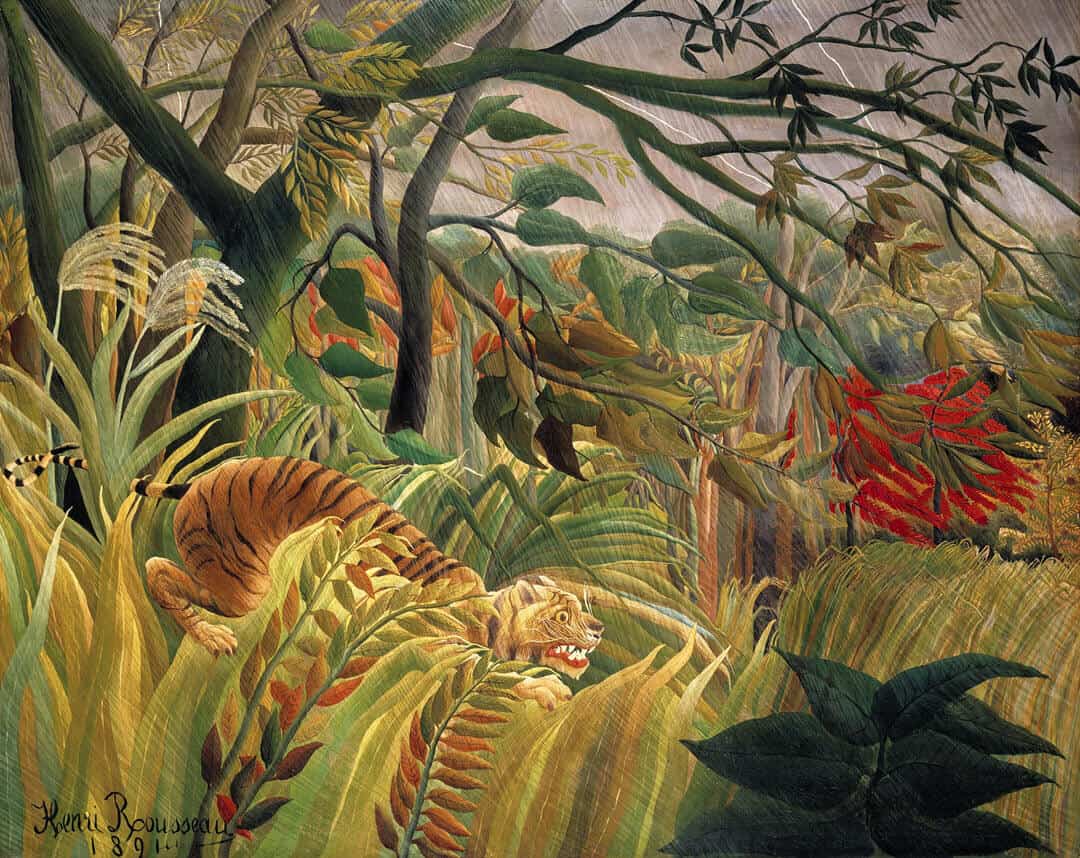
References and quotes
“Of all the big cats, or perhaps of all the endangered wildlife, the tiger may be both the most charismatic and most well-recognized flagship species in the world.” – 2019 Tigers of the World: Genomics and Conservation | Luo, Liu, et al.
“The Amur Tiger (Panthera tigris altaica) is one of the world’s most endangered species. Recently, habitat fragmentation, food scarcity and human hunting have drastically reduced the population size and distribution areas of Amur tigers in the wild, leaving them on the verge of extinction.” – 2011 Habitat evaluation of wild Amur tiger (Panthera tigris altaica) and conservation priority setting in north-eastern China | Xiaofeng, Yi, et al.
“Tigers are one of the most recognized and charismatic predator on earth, yet their habitats have declined, their numbers are low, and substantial threats to their survival persist.” 2024 – A systematic literature review: Trends and current state of research on Bengal tiger (Panthera tigris tigris), 2010–2022 | Maharjan, Mareseni, et al.
Read more about tiger subspecies:

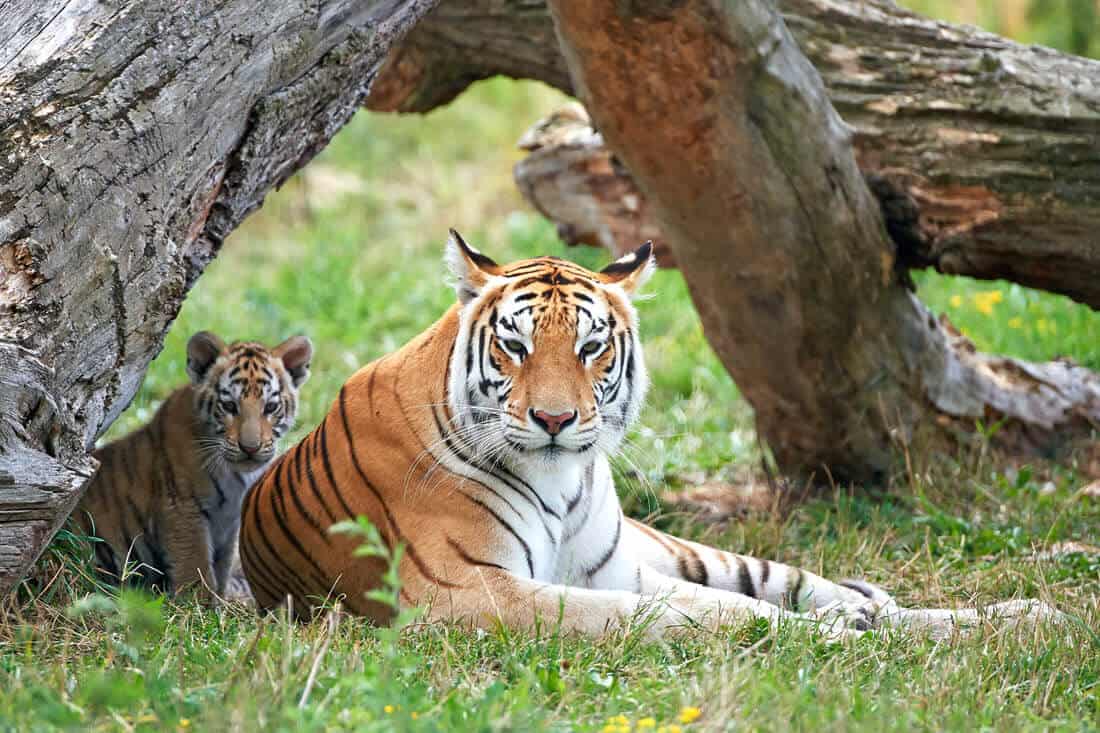
 China
China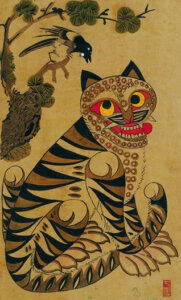 Korea
Korea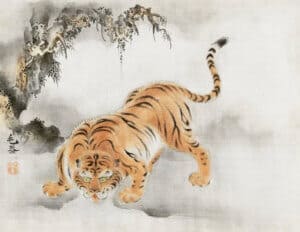 Japan
Japan
















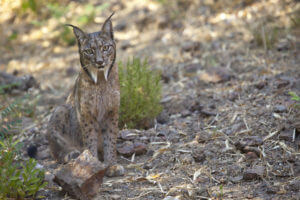




My daughter and would have really liked to see the Siberian snow tigers. Thank you ☺️